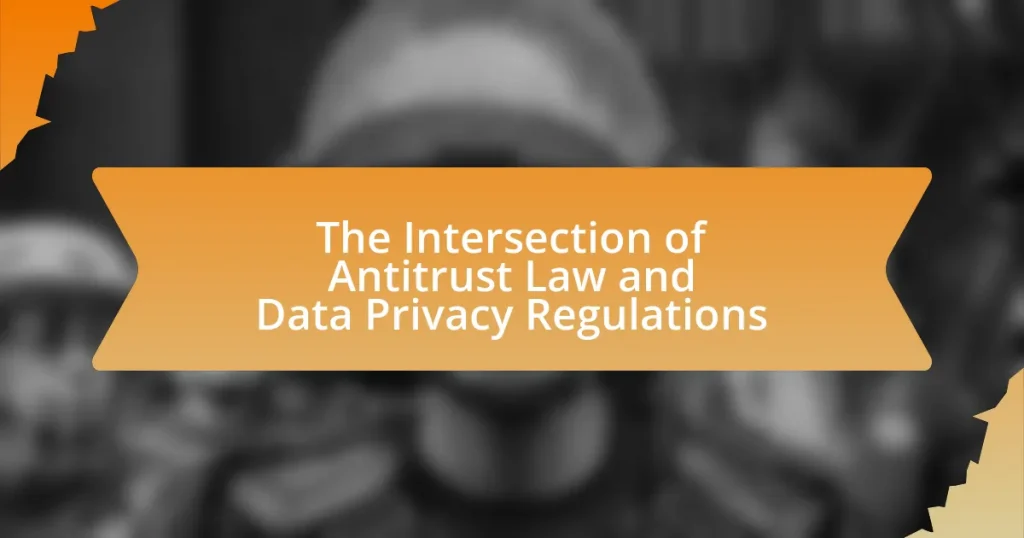The article focuses on case studies of successful antitrust actions against monopolies, highlighting the legal measures taken by government authorities to prevent monopolistic practices that hinder competition. It discusses the functioning of antitrust actions, the legal frameworks that support them, and the differences in enforcement across jurisdictions. Key case studies, such as United States v. Microsoft Corp. and the breakup of AT&T, illustrate the impact of antitrust actions on market competition, consumer choice, and innovation. The article also addresses the challenges faced in pursuing antitrust actions and offers best practices for future enforcement, emphasizing the importance of public awareness in supporting these efforts.

What are Antitrust Actions Against Monopolies?
Antitrust actions against monopolies are legal measures taken by government authorities to prevent or dismantle monopolistic practices that restrict competition. These actions aim to promote fair competition and protect consumers from the negative effects of monopolies, such as higher prices and reduced innovation. For example, the United States v. Microsoft Corp. case in the late 1990s exemplifies a successful antitrust action, where the court found Microsoft guilty of maintaining its monopoly in the PC operating systems market through anti-competitive practices, leading to significant changes in the company’s business conduct.
How do antitrust actions function in regulating monopolies?
Antitrust actions function by enforcing laws that prevent monopolistic practices and promote competition in the marketplace. These actions can include investigations, lawsuits, and regulatory measures aimed at dismantling or regulating monopolies that abuse their market power. For example, the U.S. Department of Justice successfully sued Microsoft in 1998 for antitrust violations, arguing that the company engaged in anti-competitive practices to maintain its monopoly in the PC operating system market. This case resulted in a settlement that imposed restrictions on Microsoft’s business practices, demonstrating how antitrust actions can effectively regulate monopolies and restore competitive conditions.
What legal frameworks support antitrust actions?
The legal frameworks that support antitrust actions primarily include the Sherman Act, the Clayton Act, and the Federal Trade Commission Act in the United States. The Sherman Act, enacted in 1890, prohibits monopolistic practices and restraints of trade, establishing a foundation for antitrust enforcement. The Clayton Act, passed in 1914, addresses specific practices that the Sherman Act does not clearly prohibit, such as price discrimination and exclusive dealings, thereby enhancing the regulatory framework. The Federal Trade Commission Act, also from 1914, created the Federal Trade Commission (FTC), which enforces antitrust laws and prevents unfair methods of competition. These laws collectively provide the legal basis for challenging monopolistic behavior and promoting competition in the marketplace.
How do antitrust actions differ across jurisdictions?
Antitrust actions differ across jurisdictions primarily in their legal frameworks, enforcement mechanisms, and thresholds for determining anti-competitive behavior. For instance, the United States employs a more permissive approach, focusing on consumer welfare and economic efficiency, while the European Union emphasizes market structure and competition preservation, often leading to stricter regulations. In the U.S., the Sherman Act and the Clayton Act govern antitrust laws, allowing for both civil and criminal penalties, whereas the EU’s Competition Law, particularly Articles 101 and 102 of the Treaty on the Functioning of the European Union, prohibits anti-competitive agreements and abuse of dominant positions with significant fines for violations. These differences are evident in landmark cases, such as the U.S. government’s action against Microsoft in the late 1990s, which focused on monopolistic practices, compared to the EU’s ongoing scrutiny of tech giants like Google for anti-competitive behavior, reflecting varying priorities and interpretations of competition law.
Why are antitrust actions important for market competition?
Antitrust actions are important for market competition because they prevent monopolistic practices that can stifle innovation and harm consumers. By enforcing regulations against anti-competitive behavior, antitrust actions promote a diverse marketplace where multiple firms can compete, leading to better prices, improved quality, and increased choices for consumers. Historical examples, such as the breakup of AT&T in the 1980s, demonstrate that antitrust interventions can lead to enhanced competition and technological advancements in the telecommunications industry, ultimately benefiting consumers and the economy.
What impact do monopolies have on consumers and businesses?
Monopolies negatively impact consumers and businesses by limiting competition, which leads to higher prices, reduced product quality, and less innovation. When a single entity dominates a market, consumers face fewer choices and may pay inflated prices due to the lack of competitive pressure. For example, a study by the Economic Policy Institute found that monopolistic practices in various industries have resulted in price increases of up to 20% for consumers. Additionally, businesses that operate in monopolized markets often struggle to innovate or improve their offerings, as the absence of competition diminishes the incentive to enhance products or services. This dynamic can stifle economic growth and reduce overall market efficiency.
How do antitrust actions promote innovation and fair pricing?
Antitrust actions promote innovation and fair pricing by dismantling monopolistic practices that stifle competition. When antitrust authorities intervene, they create a market environment where multiple firms can compete, leading to increased innovation as companies strive to differentiate their products and services. For instance, the breakup of AT&T in the 1980s resulted in the emergence of numerous telecommunications companies, which spurred technological advancements and reduced prices for consumers. Additionally, competition encourages firms to improve efficiency and invest in research and development, further driving innovation. Historical data shows that markets with robust competition tend to have lower prices and more diverse product offerings, validating the positive impact of antitrust actions on both innovation and pricing.

What are Notable Case Studies of Successful Antitrust Actions?
Notable case studies of successful antitrust actions include the United States v. Microsoft Corporation, where the U.S. Department of Justice and 20 states sued Microsoft for monopolistic practices in the software market. The case resulted in a settlement that imposed restrictions on Microsoft’s business practices and led to increased competition in the software industry. Another significant case is the United States v. AT&T Inc., where the merger of AT&T and Time Warner was challenged, ultimately leading to a court ruling that allowed the merger but set a precedent for scrutinizing vertical mergers. These cases illustrate the effectiveness of antitrust actions in promoting competition and preventing monopolistic behavior.
Which landmark cases have shaped antitrust law?
The landmark cases that have shaped antitrust law include the Sherman Antitrust Act of 1890, which established the foundation for antitrust enforcement in the United States. Notable cases under this act include United States v. Standard Oil Co. (1911), where the Supreme Court ruled that Standard Oil’s monopoly was illegal and ordered its breakup into smaller companies. Another significant case is United States v. Microsoft Corp. (2001), which addressed anti-competitive practices in the software market, leading to a settlement that imposed restrictions on Microsoft’s business practices. Additionally, the case of United States v. AT&T Inc. (1982) resulted in the breakup of AT&T’s monopoly over telephone service, demonstrating the government’s commitment to promoting competition. These cases collectively illustrate the evolution and enforcement of antitrust laws aimed at preventing monopolistic practices.
What were the key outcomes of the Microsoft antitrust case?
The key outcomes of the Microsoft antitrust case included a settlement that imposed significant restrictions on Microsoft’s business practices and a requirement for the company to share its application programming interfaces (APIs) with third-party developers. The U.S. District Court for the District of Columbia ruled in 2000 that Microsoft had violated the Sherman Antitrust Act by maintaining its monopoly in the PC operating system market. As a result, Microsoft faced increased scrutiny and regulatory oversight, which aimed to promote competition and innovation in the software industry. The case ultimately led to the separation of Microsoft’s software and operating system divisions, although this separation was later overturned in a settlement agreement in 2001.
How did the breakup of AT&T influence telecommunications?
The breakup of AT&T in 1982 significantly influenced telecommunications by fostering competition and innovation in the industry. This landmark antitrust action led to the divestiture of AT&T’s local exchange services, resulting in the creation of seven regional Bell operating companies. As a consequence, new market entrants emerged, which stimulated advancements in technology and services, such as the development of cellular networks and the expansion of internet access. The Federal Communications Commission reported that competition led to lower prices and improved service quality for consumers, demonstrating the positive impact of breaking up a monopoly on the telecommunications landscape.
What lessons can be learned from these case studies?
The lessons learned from case studies of successful antitrust actions against monopolies include the importance of regulatory vigilance, the necessity of robust legal frameworks, and the effectiveness of consumer advocacy. Regulatory vigilance is crucial, as demonstrated by the U.S. government’s successful breakup of AT&T in 1982, which restored competition in the telecommunications market. A robust legal framework is essential, as seen in the European Union’s actions against Microsoft, which enforced compliance and promoted fair competition. Additionally, consumer advocacy plays a significant role, illustrated by the public support for antitrust actions that can lead to more equitable market conditions. These case studies highlight that proactive measures, legal enforcement, and public engagement are vital for maintaining competitive markets.
How did these cases affect future antitrust enforcement?
These cases significantly shaped future antitrust enforcement by establishing precedents that strengthened regulatory frameworks. For instance, landmark cases like United States v. Microsoft Corporation in 2001 demonstrated the government’s ability to challenge monopolistic practices, leading to more aggressive scrutiny of tech giants. This case, along with others, prompted the Federal Trade Commission and the Department of Justice to adopt a more proactive stance in investigating and prosecuting anti-competitive behavior, as evidenced by the increased number of antitrust investigations initiated in the following years. Additionally, the outcomes of these cases influenced legislative discussions, resulting in calls for updated antitrust laws to address modern market dynamics, particularly in digital markets.
What strategies were effective in these successful actions?
Effective strategies in successful antitrust actions against monopolies include thorough market analysis, robust legal frameworks, and strategic alliances. Market analysis allows regulators to identify anti-competitive practices and assess market dominance, as seen in the U.S. v. Microsoft case, where detailed examination of software market dynamics was crucial. Robust legal frameworks, such as the Sherman Act, provide the necessary legal basis for challenging monopolistic behavior, evidenced by the breakup of AT&T in the 1980s, which was facilitated by clear legal standards. Strategic alliances among regulators, consumers, and competitors enhance enforcement efforts, as demonstrated by the European Commission’s coordinated actions against Google, which leveraged collective insights to address anti-competitive practices effectively.

How do Successful Antitrust Actions Impact the Market?
Successful antitrust actions impact the market by promoting competition, lowering prices, and enhancing consumer choice. For instance, the U.S. v. Microsoft case in the late 1990s led to significant changes in the software industry, resulting in increased competition from other software developers and a decrease in prices for consumers. Additionally, the breakup of AT&T in the 1980s fostered competition in the telecommunications sector, which led to innovation and improved services. These actions demonstrate that effective antitrust enforcement can dismantle monopolistic practices, thereby creating a more dynamic and competitive market environment.
What changes occur in the market post-antitrust action?
Post-antitrust action, market changes typically include increased competition, lower prices, and enhanced consumer choice. For instance, after the breakup of AT&T in 1982, the telecommunications market saw the emergence of multiple service providers, leading to reduced rates and innovative services for consumers. Additionally, antitrust actions often result in the dismantling of monopolistic practices, allowing smaller firms to enter the market, which fosters innovation and improves service quality. Historical data shows that markets subjected to antitrust scrutiny tend to experience a revitalization of competition, benefiting consumers and the economy overall.
How do successful actions affect consumer choices?
Successful actions, particularly antitrust actions against monopolies, significantly enhance consumer choices by promoting competition in the marketplace. When monopolistic practices are challenged and dismantled, new entrants can emerge, leading to a wider variety of products and services available to consumers. For instance, the U.S. government’s antitrust case against Microsoft in the late 1990s resulted in increased competition in the software industry, which ultimately led to more innovative products and lower prices for consumers. This illustrates that successful antitrust actions can directly influence consumer choices by fostering an environment where multiple options are available, thereby empowering consumers to make informed decisions based on quality, price, and service.
What role do these actions play in preventing future monopolies?
Successful antitrust actions play a critical role in preventing future monopolies by dismantling existing monopolistic structures and promoting competitive market conditions. These actions, such as breaking up companies or imposing regulations, create an environment where multiple firms can thrive, thereby reducing the likelihood of any single entity dominating the market. For instance, the breakup of AT&T in the 1980s led to increased competition in the telecommunications sector, resulting in lower prices and improved services for consumers. This historical precedent illustrates how effective antitrust enforcement can deter monopolistic behavior and encourage a diverse marketplace, ultimately safeguarding consumer interests and fostering innovation.
What are the challenges faced in pursuing antitrust actions?
Pursuing antitrust actions faces several challenges, primarily including the complexity of proving anti-competitive behavior, the high costs associated with litigation, and the potential for lengthy legal processes. Proving anti-competitive behavior requires substantial evidence that demonstrates harm to competition, which can be difficult to gather and interpret. Additionally, antitrust cases often involve extensive legal and expert fees, making them financially burdensome for plaintiffs. The legal processes can also be protracted, with cases taking years to resolve, which may deter potential plaintiffs from initiating actions. These challenges are evidenced by historical antitrust cases, such as the Microsoft antitrust case, which spanned over a decade and involved significant legal expenses and complex legal arguments.
How do corporations respond to antitrust investigations?
Corporations typically respond to antitrust investigations by engaging in legal defenses, public relations strategies, and compliance adjustments. Legal defenses often involve hiring legal teams to challenge the validity of the investigation or to negotiate settlements. For instance, in the case of Microsoft in the late 1990s, the company mounted a vigorous legal defense against antitrust claims, arguing that its practices were pro-competitive. Public relations strategies may include campaigns to influence public perception and demonstrate the benefits of their business practices. Additionally, corporations may adjust their compliance protocols to align with regulatory expectations, as seen when Google modified its advertising practices following scrutiny from antitrust authorities. These responses are aimed at mitigating potential penalties and maintaining market position.
What obstacles do regulators encounter in enforcement?
Regulators encounter several obstacles in enforcement, primarily including limited resources, legal complexities, and political pressures. Limited resources hinder regulators’ ability to conduct thorough investigations and pursue cases effectively, as seen in the Federal Trade Commission’s challenges in addressing large-scale monopolistic practices. Legal complexities arise from the intricate nature of antitrust laws, which require extensive legal expertise and can lead to prolonged litigation, exemplified by the lengthy court battles in cases like United States v. Microsoft. Political pressures can influence regulatory actions, as seen when public opinion or lobbying efforts sway decision-making, potentially leading to less aggressive enforcement against powerful corporations.
What best practices can be adopted for future antitrust actions?
Future antitrust actions can adopt best practices such as enhancing data transparency, utilizing economic analysis, and fostering collaboration among regulatory bodies. Enhancing data transparency allows regulators to access and analyze relevant market data, which can lead to more informed decisions. Utilizing economic analysis helps in understanding market dynamics and the potential impact of monopolistic practices, as evidenced by the U.S. Department of Justice’s reliance on economic models in the AT&T merger case. Fostering collaboration among regulatory bodies, both domestically and internationally, can streamline enforcement efforts and ensure consistent application of antitrust laws, as seen in the coordinated actions against Google by multiple countries. These practices can lead to more effective and efficient antitrust enforcement.
How can regulators improve their approach to antitrust cases?
Regulators can improve their approach to antitrust cases by adopting a more data-driven and proactive strategy. This involves utilizing advanced analytics and economic modeling to better assess market dynamics and competitive behavior. For instance, the Federal Trade Commission’s use of empirical data in the Google antitrust case demonstrated how data analysis can reveal anti-competitive practices effectively. Additionally, regulators should enhance collaboration with international counterparts to address global monopolistic behaviors, as seen in the coordinated actions against tech giants by the European Union and the United States. By focusing on these strategies, regulators can more effectively identify and address anti-competitive practices, ensuring fair market competition.
What role does public awareness play in supporting antitrust actions?
Public awareness plays a crucial role in supporting antitrust actions by mobilizing public opinion and influencing policymakers. When the public is informed about monopolistic practices and their negative impacts, it creates pressure on government agencies to take action. For instance, the public outcry during the 2019 congressional hearings on big tech companies highlighted widespread concerns about market dominance, leading to increased scrutiny and potential regulatory changes. This demonstrates that heightened awareness can lead to tangible outcomes in antitrust enforcement, as seen in historical cases like the breakup of AT&T in the 1980s, which was partly driven by public concern over its monopolistic control over telecommunications.



